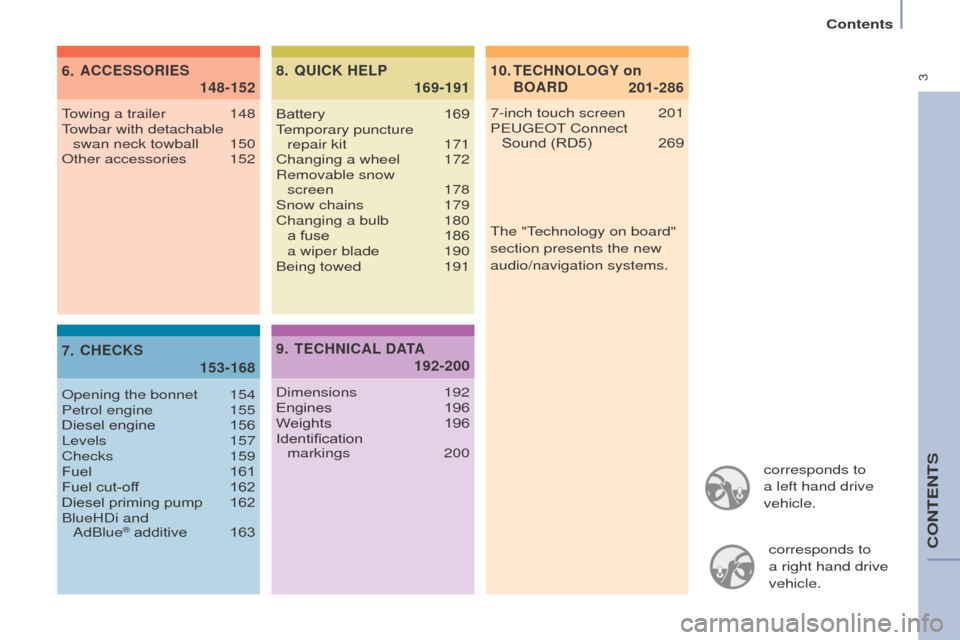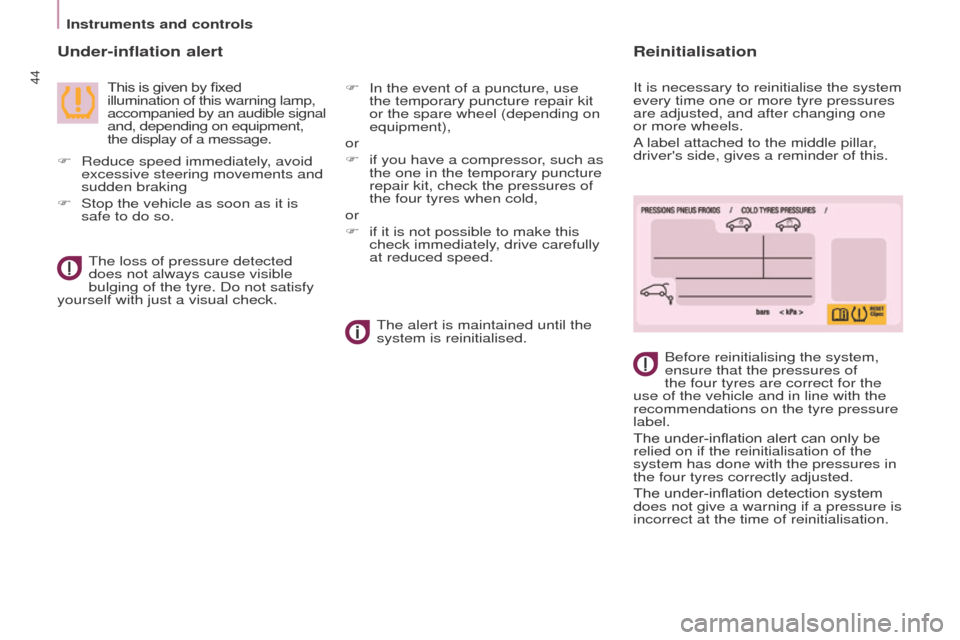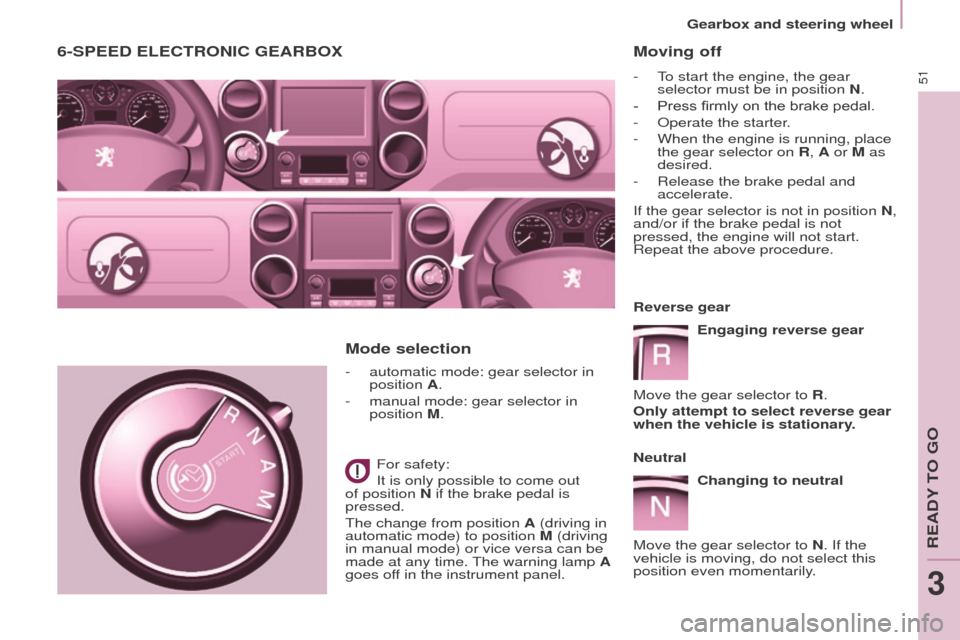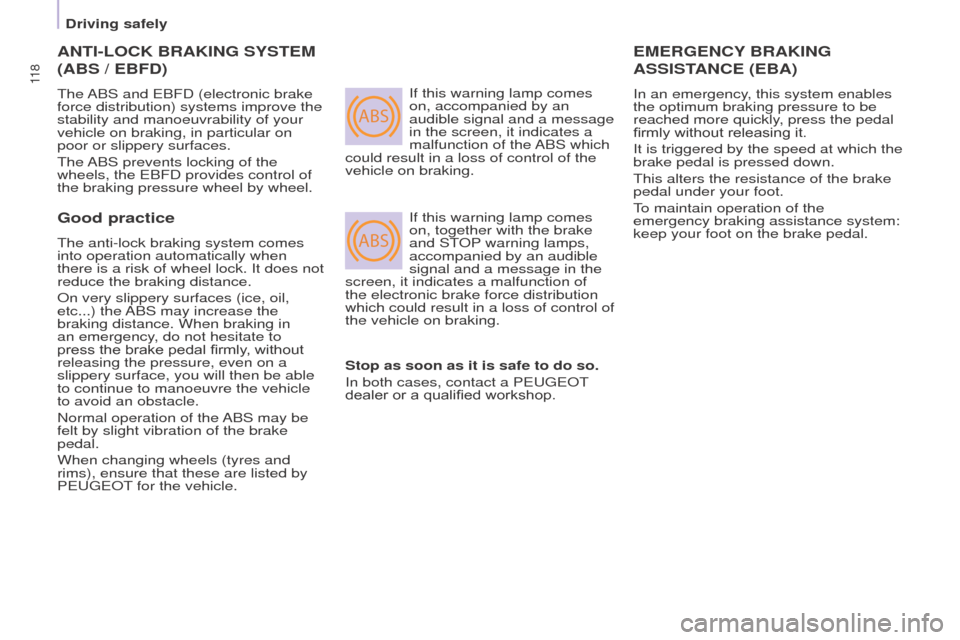Changing wheel Peugeot Partner Tepee 2016 Owner's Manual
[x] Cancel search | Manufacturer: PEUGEOT, Model Year: 2016, Model line: Partner Tepee, Model: Peugeot Partner Tepee 2016Pages: 296, PDF Size: 10.76 MB
Page 5 of 296

3
Contents
corresponds to
a left hand drive
vehicle.corresponds to
a
right hand drive
vehicle.
10.
201-286
te CHN o L og Y on
B o ARD
6.
148-152
ACC
e
SS
o
RI
e
S
7.
153-168
CH
e
CKS 8.
169-191
Q
u
ICK H
e
LP
7-inch touch screen 201
P eugeo T Connect
Sound (RD5)
269
T
owing a trailer
148
T
owbar with detachable swan neck towball
150o
ther accessories
152
o
pening the bonnet
154
Petrol engine
155
Diesel engine
156
Levels
157
Checks
159
Fuel
161
Fuel cut-of
f
162
Diesel priming pump
162
BlueHDi and
AdBlue
® additive 163 Battery
169
T
emporary puncture
repair kit
171
Changing a wheel
172
Removable snow
screen 178
Snow chains
179
Changing a bulb
180 a fuse
186 a wiper blade
190
Being towed
191
9.
192-200
te
CHNICAL DAtA
Dimensions 192
Engines 196
W
eights
196
Identification
markings
200The "Technology on board"
section presents the new
audio/navigation systems.
CoNTeNTS
Page 7 of 296

5
Location
exteRIoR
Remote control 18-19
Changing the battery ,
reinitialisation
19
Key
18
Starting
55
Hill start assist
56
Central locking / unlocking
18, 27
Filler cap, fuel tank
161-162
Fuel cut-of
f, Diesel priming
162
AdBlue® additive,
topping up 38-39, 163-168
Wiper blades
190
Door mirrors
1
11
Side repeaters
183
Active City Brake
122-125
Front lamps, foglamps, direction indicators
58-60, 180-183
Headlamp beam height adjustment
60
Changing front bulbs
180-183
Headlamp wash
62, 158
Snow cover
178
Front doors
21
Sliding side doors
22-23
Key
18o
pening the bonnet
154
Child lock
147
T
owing, lifting
191
T
owbar,
swan neck towball
148-151
Parking sesnsors
1
15-116
Reversing camera
1
17
Rear roof flap
26e
mergency control
23
Spare wheel, jack,
changing a wheel, tools
172-177
T
emporary puncture repair kit
171
Inflation, pressures
200
Zenith roof
98-99, 102
Roof bars
103
Rear lamps,
direction indicators
58-59
3rd brake lamp
185
Changing
rear bulbs
180-181, 184-185
Doors, tailgate
23-25
Accessories
152
Dimensions
192-195
Brakes, pads
1
14, 157, 159
e
mergency braking
1
18
ABS,
e
BFD
1
18
ASR, DSC
1
19
g
rip control
120-121
Active City Brake
122-125
T
yres, pressures
200
Snow chains
179
T
yre under-inflation detection
4
1-42
Tyre under-inflation detection with reinitialisation
43-46
Number plate lamps
185
1
oVeRVIeW
Page 8 of 296

6
Location
Rear view mirror 112
Front courtesy lamp 104
Changing courtesy
lamp bulbs
183 Front, lateral,
curtain airbags
129-132
Deactivating the passenger's
front airbag
132, 136
Battery
, charging,
starting
169o
pening the bonnet
154
Rear windows
1
12
Front seats, adjustments,
head restraint
77-78
Seat belts
108, 126-128
Accessories
152
INteRIoR
Rear bench seat 79-81
Rear seats
(5-seat version)
82-84, 92
Seat configuration, benches
92-93
Rear courtesy lamp
104
Changing courtesy lamp bulbs
1
83
Rear fittings
97
-
floor boxes,
-
aircraft style table,
-
side blinds,
Zenith roof
98-99
Scented air freshener
100-101
Load space cover
(5-seat version)
105
Load space cover
(7-seat version)
109-1
10 Child seats
133-142, 145
IS
o FIX mountings, seats 143-145
Parking brake, handbrake
1
14
Rear seats (7-seat version)
85-91, 93
Fittings (7-seat version)
107-108
-
cup holder
,
-
12 V socket,
-
stowing rings,
-
storage flap.
T
owing, llifting
191
T
owable loads
196-199
Spare wheel, jack,
changing a wheel, tools
1
72-177
Page 9 of 296

7
Location
Rear view mirror 112
Front courtesy lamp 104
Changing courtesy lamp
bulbs
183 Front, lateral,
curtain airbags
129-132
Deactivating the passenger's
front airbag
132, 136
Battery
, charging, starting
169o
pening the bonnet
154
Rear windows
1
12
Front seats, adjustments,
head restraint
77-78
Seat belts
108, 126-128 Accessories
152
INteRIoR
Rear bench seat 79-81
Rear seats
(5-seat version)
82-84, 92
Seat configuration, benches
9
2-93
Rear courtesy lamp
104
Changing courtesy lamp bulbs
1
83
Rear fittings
97
-
floor boxes,
-
aircraft style table,
-
side blinds,
Zenith roof
98-99
Scented air freshener
100-101
Load space cover
(5-seat version)
105
Load space cover
(7-seat version)
109-1
10
Child seats
133-142, 145
IS
o FIX mountings, seats
143-145
Parking brake, handbrake
1
14
Rear seats (7-seat version)
85-91, 93
Fittings (7-seat version)
107-108
-
cup holder
,
-
12 V socket,
-
stowing rings,
-
storage flap.
T
owing, llifting
191
T
owable loads
196-199
Spare wheel, jack,
changing a wheel, tools
172-177
1
oVeRVIeW
Page 46 of 296

Instruments and controls
44
under-inflation alert
This is given by fixed
illumination of this warning lamp,
accompanied by an audible signal
and, depending on equipment,
the display of a message.Before reinitialising the system,
ensure that the pressures of
the four tyres are correct for the
use of the vehicle and in line with the
recommendations on the tyre pressure
label.
The under-inflation alert can only be
relied on if the reinitialisation of the
system has done with the pressures in
the four tyres correctly adjusted.
The under-inflation detection system
does not give a warning if a pressure is
incorrect at the time of reinitialisation.
The loss of pressure detected
does not always cause visible
bulging of the tyre. Do not satisfy
yourself with just a visual check.
The alert is maintained until the
system is reinitialised.
F
Reduce speed immediately
, avoid
excessive steering movements and
sudden braking
F
Stop the vehicle as soon as it is
safe to do so. F
In the event of a puncture, use
the temporary puncture repair kit
or the spare wheel (depending on
equipment),
or
F
if you have a compressor
, such as
the one in the temporary puncture
repair kit, check the pressures of
the four tyres when cold,
or
F
if it is not possible to make this
check immediately
, drive carefully
at reduced speed.
Reinitialisation
It is necessary to reinitialise the system
every time one or more tyre pressures
are adjusted, and after changing one
or more wheels.
A label attached to the middle pillar,
driver's side, gives a reminder of this.
Page 51 of 296

49
MANuAL geARB ox
5-speed
6-speed
To change gear easily, always depress
the clutch pedal fully.
To prevent the mat from becoming
caught under the pedal:
-
ensure that the mat is positioned
and secured correctly on the floor
,
-
never fit one mat on top of another
.
When driving, avoid leaving your hand
on the gear knob as the force exerted,
even if slight, may wear the internal
components of the gearbox over time.
Changing into 5th or 6th gear
To engage the gear correctly, move the
gear lever fully to the right.
engaging reverse gear
The lever should be moved slowly
to reduce noise.
To engage reverse gear, wait until the
vehicle has come to a complete stop.
SteeRINg WH ee L ADJ u S t M e N t
When the vehicle is stationary,
release the steering wheel adjustment
mechanism by pulling the lever.
Adjust the steering wheel for height
and reach, then lock the mechanism by
pushing the lever fully forward. In the 6-speed configuration, raise the
collar below the gear knob.
gearbox and steering wheel
ReADY To go
3
Page 53 of 296

51
6-SPeeD eLeCtRoNIC geARBox
- automatic mode: gear selector in
position A.
-
manual mode: gear selector in
position
M.
For safety:
It is only possible to come out
of position N if the brake pedal is
pressed.
The change from position A (driving in
automatic mode) to position M (driving
in manual mode) or vice versa can be
made at any time. The warning lamp A
goes off in the instrument panel.
Mode selection Moving off
- To start the engine, the gear
selector must be in position N.
-
Press firmly on the brake pedal.
-
o perate the starter.
-
When the engine is running, place
the gear selector on
R, A or M as
desired.
-
Release the brake pedal and
accelerate.
If the gear selector is not in position
N,
and/or if the brake pedal is not
pressed, the engine will not start.
Repeat the above procedure.
Reverse gear
e
ngaging reverse gear
Move the gear selector to R.
o
nly attempt to select reverse gear
when the vehicle is stationary.
Neutral
Changing to neutral
Move the gear selector to N. If the
vehicle is moving, do not select this
position even momentarily.
gearbox and steering wheel
ReADY To go
3
Page 54 of 296

52
Acceleration
For optimum acceleration (e.g. to
overtake another vehicle), simply
press the pedal beyond the point of
resistance at the end of its travel, by
pressing down firmly.
Vehicle stationary, with the
engine running
In the event of a prolonged stop with
the engine running, the gearbox
changes automatically to neutral N.
Stopping the vehicle
Before stopping the engine, put the
gear selector in position N.
In all cases, it is essential to apply
the parking brake. Check that the
parking brake warning lamp is on in the
instrument panel.Before doing anything in the
engine compartment, check that
the gear selector is in neutral N.
Changing gear
In situations of high engine speeds
(heavy acceleration), a change
up will not occur unless the driver
operates the electronic gearbox control
paddle. Pull on the "+" control
paddle to change up.
Pull on the "-" control
paddle to change
down.
-
If the vehicle stops or reduces
speed (for example when
approaching a stop sign),
the gearbox changes down
automatically
, to first gear if
needed.
-
It is not necessary to release the
accelerator completely during gear
changes.
-
A
gear change instruction is
accepted only if the engine speed
permits.
-
For safety reasons, depending on
the engine speed, a change down
may be performed automatically
.
Manual mode
Changing to manual mode
Move the gear selector to M. Automatic mode Changing to automatic
mode
Move the gear selector to A.
The gearbox then operates in
automatic mode, without any action on
your part.
It constantly selects the gear that is
best suited to the following conditions:
-
driving style,
-
road profile,
-
optimum fuel consumption.
gearbox and steering wheel
Page 104 of 296

102
ZeNItH RooF BARS
The maximum authorised weight on
each roof bar is 35 kg.In all cases, the load must rest on
the non-slip bands provided for this
purpose and must not touch the roof or
the glazing of the roof.
Recommendations for loading the
roof
This procedure requires the use of
a spanner supplied with the tools for
changing a wheel.
These two longitudinal Zenith roof bars
can be removed.
Chapter 9, "Changing a wheel"
section.
-
o pen the protective covers.
-
Slacken the four screws using the
spanner and remove them.
-
T
urn the bars 90° placing the
hollow parts towards the front.
-
Refit the the 4 screws and tighten
them using the spanner
.
-
Close the protective covers.
-
u se the strap passages A only to
secure the load firmly.
Practical information
Page 120 of 296

ABS
ABS
11 8
ANtI-LoCK BRAKINg SYSteM
(ABS / e BFD)
The ABS and eBFD (electronic brake
force distribution) systems improve the
stability and manoeuvrability of your
vehicle on braking, in particular on
poor or slippery surfaces.
The
ABS prevents locking of the
wheels, the
e BFD provides control of
the braking pressure wheel by wheel. If this warning lamp comes
on, accompanied by an
audible signal and a message
in the screen, it indicates a
malfunction of the ABS which
could result in a loss of control of the
vehicle on braking.
If this warning lamp comes
on, together with the brake
and ST
o
P warning lamps,
accompanied by an audible
signal and a message in the
screen, it indicates a malfunction of
the electronic brake force distribution
which could result in a loss of control of
the vehicle on braking.
eMeRgeNCY BRAKIN g
ASSIS
t
ANC
e ( e BA)
In an emergency, this system enables
the optimum braking pressure to be
reached more quickly, press the pedal
firmly without releasing it.
It is triggered by the speed at which the
brake pedal is pressed down.
This alters the resistance of the brake
pedal under your foot.
To maintain operation of the
emergency braking assistance system:
keep your foot on the brake pedal.
good practice
The anti-lock braking system comes
into operation automatically when
there is a risk of wheel lock. It does not
reduce the braking distance.
o
n very slippery surfaces (ice, oil,
etc...) the ABS may increase the
braking distance. When braking in
an emergency, do not hesitate to
press the brake pedal firmly, without
releasing the pressure, even on a
slippery surface, you will then be able
to continue to manoeuvre the vehicle
to avoid an obstacle.
Normal operation of the ABS may be
felt by slight vibration of the brake
pedal.
When changing wheels (tyres and
rims), ensure that these are listed by
P
eugeo T for the vehicle. Stop as soon as it is safe to do so.
In both cases, contact a P
eugeo T
dealer or a qualified workshop.
Driving safely